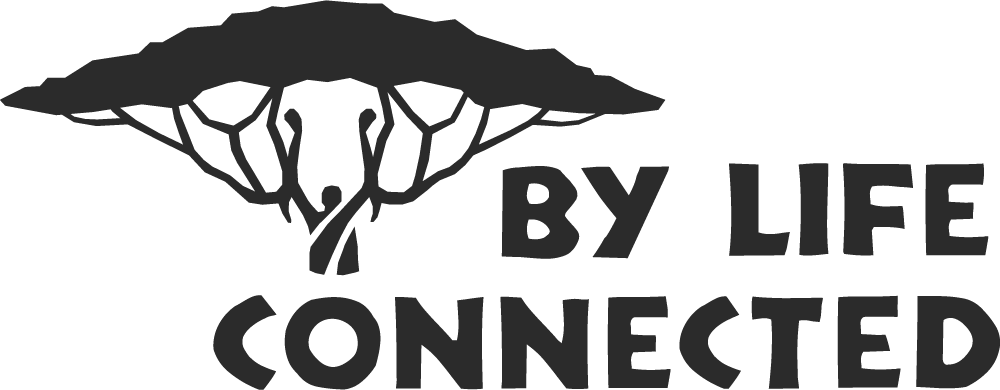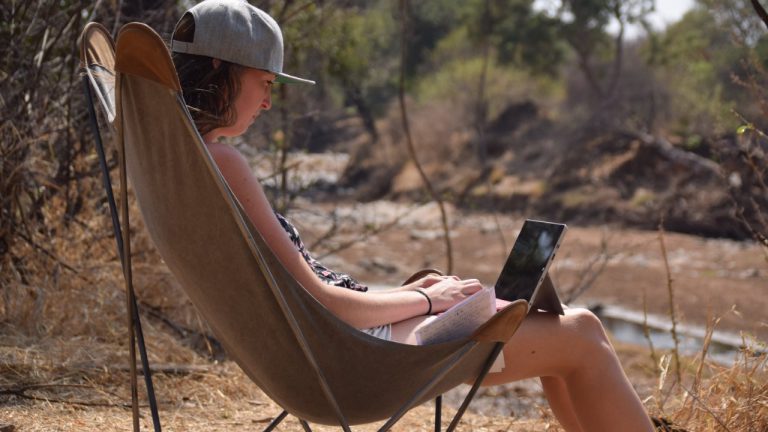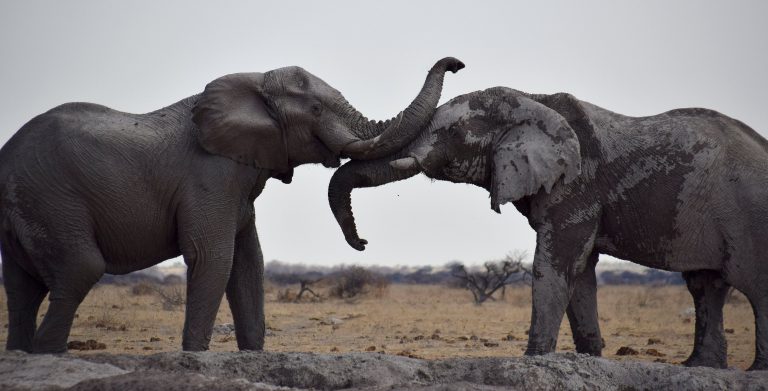Kaokoveld – A pathway into another world
Silence… No cars moving in the distance, no chirping sounds of birds, not even a touch of wind. Complete silence… It truly can be deafening, as they say. We were parked on top of a mountain pass, lying in our rooftop tent with all the blinds open. We had crawled into our sleeping bags, looking like big cocoons with only our heads sticking out, the only parts exposed to the chilly night air. Above us was the night sky in its full glory, the Milky Way stretching from one side of the horizon to the other. What a night, what a place!

Our beautiful view on the mountain top!
Three days earlier we entered the region called Kaokoveld, which lies in the north-west of Namibia. It is believed to be one of the true remaining wildernesses of southern Africa and we were there to test this statement. It is known for its rough terrain and roads, the beautiful landscapes and the local tribe called the Himba. You have probably seen them on the telly or a magazine. The Himba, especially the women, still hold on to their traditions by “dressing” as they have done for who knows how long. As the quotation mark implies the Himba women live in a fairly naked state; their boobs can freely enjoy the wild outdoors (no cloth to hold them back from encroaching on lower regions), as is most of the rest of their body except (luckily) their mid-level private parts. To accent their features, and protect them from the sun, they cover themselves with oker, which gives their skin a beautiful dark red colour.

Two Himba woman and Kellie
The unofficial capital of the Himba is Opuwo. Driving into this city felt other-worldly, almost like entering a Star Wars movie. In addition to the Himba, the Herero people also call the Koakoveld region their home. Almost to compensate for the cloths that the Himba lack, the Herero women wear long dresses in any colour imaginable as bright as they get (imagine bright pink or fluorescent green) and they finish their style with a hat that would even make our former queen, princes Beatrix, very jealous. The hats have two cool features: firstly, they always seem to match the dress and secondly, they protect the wearer from the scorching sun with a very interesting cap that has the shape of a triangle. Can you imagine that? Now imagine these beautiful people living side-by-side in a small city in the middle of a desert world, kinda begins to feel like Star Wars, huh? Very cool!!
The funny thing is that when arriving in Opuwo, you don’t really have time to adjust to this very different culture. The reason for our visit to this city was partly to prepare for the upcoming trip to the wilderness of Kaokoveld; we had to fuel up the car and get enough provisions to last us at least five days. The first thing we did was a visit to the fuel station where we were immediately bombarded by Himba ladies. Now, you have to know that I am very loyal to Kellie and I think it is very disrespectful to look at a woman’s “Tha-Thas!”, but… When they stand right in front of you to offer you their goodies (here, I mean other type of merchandize ?) it is very hard not to have a peek. Luckily for me, Kellie agreed.
Even though we had to get used to it and might make it sound like we’re making fun of it, it was pretty obvious how proud these woman are of their heritage, and you can’t do anything else than respect that. It is amazing how much royalty they radiate and I felt a vicarious pride for them!

A real African sunset!
The other reason why we were in Opuwo is because we wanted to visit an organization that supports local communities in setting up a conservancy. This organization is called Integrated Rural Development and Nature Conservation (thankfully in short, IRDNC). Read more about IRDNC and our visit on the Projects Page, here (not yet published).
After we finished with the pre-trip prep we stayed the night at IRDNC’s camp and left for Kaokoveld the next morning. Now, the previous blog ended with us breaking our rear shocks in Etosha NP. Although we fixed some new shocks we didn’t have the chance to thoroughly test them out. With the reputation of Kaokoveld, the knowledge that we need to cross and drive in some riverbeds and the information that it rained a few weeks ago in mind, we were slightly nervous whether we would be able to make it (even besides considering the new shocks). What did not help was that we came across a guy that got stuck in the mud (took him 5 hours to recover the motorhome!) and I saw a 4×4 car like ours getting towed back to civilisation (didn’t tell Kellie this at the time). (Red. aka Kellie: This is the first time I heard/read about it!) Nevertheless, we decided to go anyway! Only one way of finding out if you got what it takes right?
Our goals were to make it to the dots on the map called Orumpembe and Puros. These were two of the handful of named places where people live in Kaokoveld. Our interest in these places was that they were both the “capitals” of Orumpembe and Puros Conservancy. We wanted to know if the local people benefit from setting up a Conservancy, how they do it, what resources they use and if they use those resources sustainably. We already visited a Conservancy (called Mayuni) in the Zambezi (former Caprivi) region, which worked surprisingly well. It would be interesting to see if their performance is shared with more Conservancies in Namibia or that it was special.
The first night we wanted to sleep at a campsite about 15 kilometers north of Orumpembe, it was called The House on the Hill. We had to drive about 150 kilometers that day to reach it. Doesn’t sound like that great of a distance, right? Well, it took us close to the whole day to reach it. The first section of road from Opuwo was still okay, relatively speaking. We could drive about 40 kilometers in the first hour/hour-and-a-half. From there on the road got narrower, rockier and hillier (including river bed crossings, which luckily were dry). Can’t imagine we drove faster than 20 kilometers per hour on average. We weren’t bored or frustrated for a second though, because the scenery was nothing less than spectacular (like New-Zealand spectacular, but then dry)! Slowly, as we proceeded, the landscape began to change; the trees and shrubs started to disappear, the mountains became higher and valleys in between flatter. It became more arid. For us this meant that the closer we got to our campsite the more we had to stop to enjoy the landscape and take some photographs. This probably contributed a lot to why it took us the whole day to reach the campsite .
With about 10 kilometres to go we noticed something strange in the distance. It looked like the dust trail of a car, but than huge. At a certain moment Kellie shouted: “it is a sand storm!” Now this is of course really cool, but according to our GPS the sand storm seemed to be in the exact location of our campsite! We drove on, we could always camp somewhere in the wild if necessary. The sand storm had a Namibian desert style orange colour, and as we got closer we could begin to see how the strong westerly ocean winds picked up the sand that was lying on a big plain. Luckily for us, we noticed now that our campsite was positioned just behind the sand storm, on the other side of a hill. We had to go through it though to get there. Just before we entered the storm we closed the windows and drove through. From a far it looked a lot more impressive and we past the sandy plain unharmed.

The small sandstorm!
The campsite was set against a hill (yes, with a house on it) and next to a dry riverbed. We had a lovely braai that night including portobello’s with goat cheese, puffed sweet potatoes and roasted corn. A local dog must have smelled our feast as he paid us a visit to search for scraps. He looked starved and Kellie gave him some bread, a can of salmon and lots of water. I think she made friends for life! (Red. one of the sweetest dogs we’ve come across!)

View on the sunset from the campsite!
The next morning, we talked with a guy called Exit (awesome nickname!) from the Conservancy (read about it here) and afterwards we left for the next destination, Puros. We noticed that in Kaokoveld you have always two options in going somewhere: through the riverbed or next to it. These roads are often connected every few kilometers, which meant that we could get out of the riverbed at any time if the riverbed was getting muddy or worse. Again, we felt empowered by the Tracks4Africa app which showed every little road there was with such accuracy! So, we decided to just give it a try! We deflated the tyres and drove right in. What a great decision that was! For a whole day we drove through a dry but green riverbed with on both sides stunning mountains. We found oryx, ostriches, giraffe and… a donkey?! From a distance it looked like the donkey was hopping strangely, but when we got closer we noticed that its front legs were tight by a rope. Who does such a thing?! We stopped and had a closer look. The rope was burning through its skin and the donkey clearly was struggling to move around. We decided to do something about it. We first tried to gain the donkeys trust by giving it some bread, but it didn’t want any of it. Maybe some water than? Nope, no interest. It was still hopping away from us. The donkey left us without options, we needed to corner him. On a ridge next to riverbed we sparred with the donkey; we tried to get close, the donkey turned its bottom to us as if to kick us and we had to retreat. This went on for about 10 minutes until the donkey finally surrendered and stood still. I talked to him with my soothing voice to keep him calm (red. Yeah right), while Kellie cut the rope. And we succeeded! The rope gave way and the donkey walked away as if nothing has happened. Good for you donkey!
Not long after that we left the riverbed and went up a mountain pass. The plan was to go down the mountain on the other side to another riverbed. When we made it to the top of the pass though, we decided to stop there and set up camp on the highest point, the view was simply too good to drive on. The wind was relentless up there and for about three hours we just sat in the wind (and sun) shade behind the car. With the sun almost setting we positioned ourselves for the show and waited…
With the sun dropping behind the mountains, the wind steadily ceased until it was completely quiet. In the beginning it is kind of unnerving (especially in the darkness), as if something can jump at you in any second. But you quickly get used to it and it is quite special! That night we set the alarm at 2.30 AM (we were sure that the moon would be gone by then) to learn how to make photographs of the night sky. When we woke up, the stars were magnificent!
To get a sense of how desolate this place is. The Kaokoveld is about 45 thousand square kilometres (the Netherlands is about 41 thousand square kilometres) and only a couple of thousand people live in it (excluding Opuwo). We didn’t come across another car while driving for two days straight. I think it is something very special that such places still exist, and we should cherish it as much as we can. And some of you might think that this is dangerous; what if the car breaks down!? If calamity strikes, and we get bogged or have a break down, we could always live with the Himba for a week or so until someone rescued us!
Nothing of the kind happened though! Sisi could take anything that Kaokoveld had to offer. With our confidence boosting we drove off down the other side of the mountain a couple hours after sunrise. Closing up on the next valley we drove around a part of the mountain and saw the next riverbed in the distance. Absolutely stunning! It looked like a piece of the Sahara with a riverbed oasis (including palm trees), but then with orange sand and placed between two mountain ridges. The vegetation was surprisingly lush, and we had the whole valley to ourselves. Well, besides the few giraffes and oryx of course!
Just after lunch we arrived in Puros and set up camp, and cleaned out the car (dust was accumulating) after which we had a very short talk with a guy from the Puros Conservancy. We did some relaxing in the hammock and had a nice braai and the following morning we moved on to the next place, through, again, a different landscape. The Ongongo hotspring, this is a natural spring and the waterfall coming down was warm water! Here we camped and relaxed some more (Lars by playing around with the camera). This was our last stop in Kaokoveld and unfortunately we only found a lot of dung and no desert elephants. But! They also hang out in the next area we’re going; Damaraland. You can read more about this in our next blog!
Lars playing around with the camera, making pictures of the weavers above the pool!





Happy New Year! sorry for late reply, my phone was in a mess, I couldn’t read clearly. I’m glad you achieved your goals as planned…………………. your journey to koakovelt was beautiful , I wish i accompanied you,guys, I could end up having a Himba woman. Go and tell the world what you have experienced about African people. I ‘m wishing you a glorious New Year and may God bless you to achieving your mission. I wish we could me again.
Thank you,! You gave word and image to memories that have rested in my soul since ca. 1948 when as a teenager, I accompanied two German friends living in Angola on a horse-buying trip to Namibia. At night, we drove at night often because of the heat, I would lie on the back of the truck and count the stars, then wake to see herds rushing to the sparse watering places. You captured the grandure, the calm, the generosity of the land that let you be there and see it, you could trust it. That, and three years in Angola, gave me a view of nature very different from my American peers. I am proud that you are from Holland. I have beautiful grandchildren there. Thank you.
Thank you so much for your message. To read such a lovely note and that our story helped reinforce your memories, that definitely made our day. Sounds like you had both a very different and very similar experience to us! But either way, what an adventure to be in that desert, that hasn’t changed one bit. Thanks again for starting our day of in such a lovely way :).